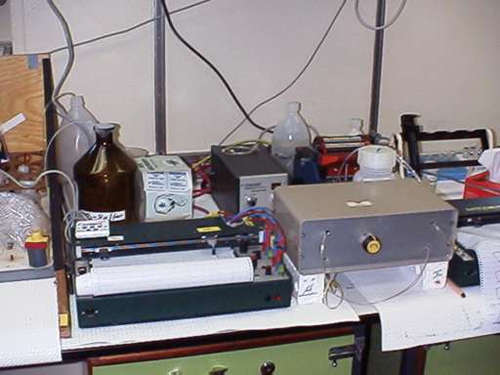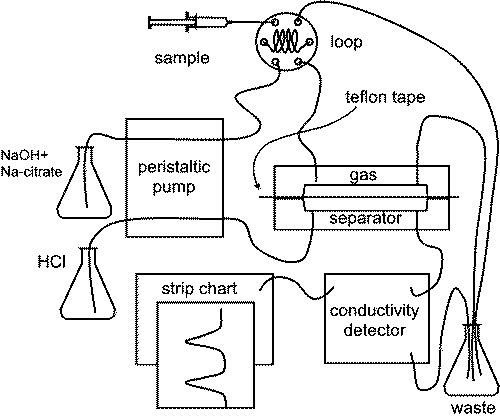| method | By addition of alkaline buffer solution NH4 is transformed to NH3. NH3 passes a teflon membrane and dissolves in a HCl solution on the other side of the membrane. The conductivity change due to this process is detected. |
| setup | 
|
| pump | Ismatec peristaltic pump |
| pump tubes | tygon tubing, coding white - white |
| valve | low pressure injection valve Upchurch #V-450 with 100 µl sample loop... we recently returned to a standard Rheodyne 7725 manual HPLC injection valve since the Upchurch low pressure valve did not last too long |
| detector | Knauer
conductivity detector. A very good little detector setup
was an Amber
Science Model 1056 Conductivity meter with a Model
529 Micro Flow Thru Cell. Unfortunately
those meters have been discontinued by Amber Science. If
you still use those meters and you need information
/ manuals help with repairs please click here |
| capillary | PEEK tube 0.04" I.D. 1/16" O.D. Upchurch #1538 |
| data recording | strip chart recorder |
| gas separator | The gas separator consits of two pieces of plexiglass each with a 5x200x0.5 mm groove and a boring for solution supply and release on both ends of the grooves. The plexiglass pieces are mounted together with bolts with the grooves facing on the inside. The solution streams through the two grooves is separated by teflon tape which at the same time seals the grooves. |
| membrane | We actually use standard plummer teflon tape (10x0.1 mm) |
| solutions | |
| solution 1 | 0.2 M Na citrate * 2H2O in 10 mM NaOH |
| solution 2 | 1 mM HCl |
| standard stock | 1000
ppm NH4 solution or 50 mM NH4 |
| work standards | 0.1
- 0.25 - 0.5 - 1.0 - 5.0 - 10 ppm NH4 or 5 - 10 - 25 - 50 - 250 - 500 µM NH4 work standards are prepared with filtered artificial seawater |
| setup scheme |
 |
| reference | modified after Hall, P.O.J. + Aller, R.C.(1992): Rapid small-volume flow-injection analysis for CO2 and NH4 in marine Sediments.- Limnology and Oceanography 35: 1113-1119 |